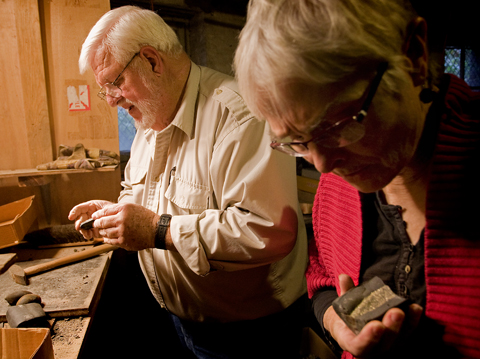
Ohio University Professor Emerita of Paleobotany Dr. Gene Mapes (right) and her husband, Royal Mapes.
Skull Structures of 325-million-year-old Shark Fossil Show Living Sharks are Evolutionarily Advanced
The skull of a newly discovered 325-million-year-old shark-like species suggests that early cartilaginous and bony fishes have more to tell us about the early evolution of jawed vertebrates—including humans—than do modern sharks, as was previously thought. The new study, led by scientists at the American Museum of Natural History, shows that living sharks are actually quite advanced in evolutionary terms, despite having retained their basic “sharkiness” over millions of years. The research is published in April in the journal Nature.
“Sharks are traditionally thought to be one of the most primitive surviving jawed vertebrates. And most textbooks in schools today say that the internal jaw structures of modern sharks should look very similar to those in primitive shark-like fishes,”said Alan Pradel, a postdoctoral researcher at the Museum and the lead author of the study. “But we’ve found that’s not the case. The modern shark condition is very specialized, very derived, and not primitive.”
The new study is based on an extremely well-preserved shark fossil collected by Ohio University professors Royal Mapes and Gene Mapes in Arkansas, where an ocean basin once was home to a diverse marine ecosystem. The fossilized skull of the new species, named Ozarcus mapesae, along with similar specimens from the same location, were part of a recent donation of 540,000 fossils from Ohio University to the Museum.
The heads of all fishes—sharks included—are segmented into the jaws and a series of arches that support the jaw and the gills. These arches are thought to have given rise to jaws early in the tree of life. Because shark skeletons are made of cartilage, not bone, their fossils are very fragile and are usually found in flattened fragments, making it impossible to study the shape of these internal structures. But the Ozarcus mapesaespecimen was preserved in a nearly three-dimensional state, giving researchers a rare glimpse at the organization of the arches in a prehistoric animal.
“This beautiful fossil offers one of the first complete looks at all of the gill arches and associated structures in an early shark. There are other shark fossils like this in existence, but this is the oldest one in which you can see everything,”said John Maisey, a curator in the Museum’s Division of Paleontology and one of the authors on the study. “There’s enough depth in this fossil to allow us to scan it and digitally dissect out the cartilage skeleton.”
Working with scientists at the European Synchrotron Radiation Facility, Pradel imaged the specimen with high-resolution x-rays to get a detailed view of each individual arch shape and organization. “We discovered that the arrangement of the arches is not like anything you’d see in a modern shark or shark-like fish,” said Pradel. “Instead, the arrangement is fundamentally the same as bony fishes.”
The authors say it’s not unexpected that sharks—which have existed for about 420 million years—would undergo evolution of these structures. But the new work, especially when considered alongside other recent developments about early jawed vertebrates, has significant implications for the future of evolutionary studies of this group. “Bony fishes might have more to tell us about our first jawed ancestors than do living sharks,”Maisey said.
In the News
Will Dunham of Reuters writes, “You’ve heard of the Model T Ford, the famed early 20th-century automobile that was the forerunner of the modern car. But how about the Model T shark?” Read more.
About the American Museum of Natural History: The American Museum of Natural History, founded in 1869, is one of the world’s preeminent scientific, educational, and cultural institutions. The Museum encompasses 45 permanent exhibition halls, including the Rose Center for Earth and Space and the Hayden Planetarium, as well as galleries for temporary exhibitions. It is home to the Theodore Roosevelt Memorial, New York State’s official memorial to its 33rd governor and the nation’s 26th president, and a tribute to Roosevelt’s enduring legacy of conservation. The Museum’s five active research divisions and three cross-disciplinary centers support 200 scientists, whose work draws on a world-class permanent collection of more than 32 million specimens and artifacts, as well as specialized collections for frozen tissue and genomic and astrophysical data, and one of the largest natural history libraries in the world. Through its Richard Gilder Graduate School, it is the only American museum authorized to grant the Ph.D. degree. In 2012, the Museum began offering a pilot Master of Arts in Teaching program with a specialization in Earth science. Approximately 5 million visitors from around the world came to the Museum last year, and its exhibitions and Space Shows can be seen in venues on five continents. The Museum’s website and collection of apps for mobile devices extend its collections, exhibitions, and educational programs to millions more beyond its walls. Visit amnh.org for more information.
Other authors on the paper include Paul Tafforeau, a beamline scientist at the European Synchrotron Radiation Facility, and Jon Mallatt, a researcher from Washington State University.
Funding for this study was provided in part by the Herbert & Evelyn Axelrod Research Chair in Paleoichthyology at the Museum.



















Comments